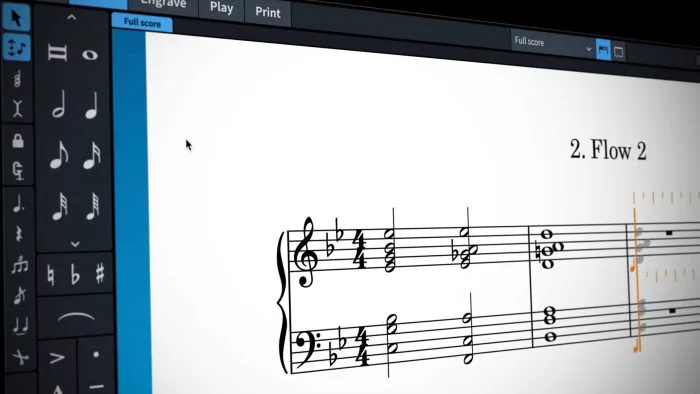Steinberg has announced the highly anticipated release of Dorico 3.5, the latest version of its professional scoring software.
The update comes with new features that expand its notational capabilities, make the workflow more customizable and streamlined, and build on its unique strengths.
Pitch before duration input
Dorico has been designed from the ground up to be a comfortable environment for composing and arranging, and the new input method introduced in Dorico 3.5 provides convenient new tools for trying out ideas during the composition process.
Dorico’s step input method has always required you to specify the duration of the note before its pitch, which is very convenient when copying out existing music, but not always convenient when composing.
Now you can specify the pitch before duration, allowing you to try out melodies and chords without inputting them, only committing them to the score when you then specify the duration to be used.
This new input method will be of particular interest to users of other notation software who want to experience all of Dorico’s powerful and time-saving features, but strongly prefer pitch before duration input: now it’s available in Dorico, too.
Richer, smarter VST Expression Maps
Today’s professional sample libraries and virtual instruments are increasingly sophisticated and require musicians to manipulate several MIDI controllers, key switches and other parameters simultaneously to get the best out of them.
Dorico 3.5 introduces powerful new tools for handling sample libraries through its expanded VST Expression Maps editor, with conditional switches — for example, to use a particular sound when a note is shorter than a certain duration in real time — and improved handling for techniques that can be combined with other sounds, without needing to define every possible combination in the expression map.
Figured bass
Dorico 3.5 expands its support for early music with comprehensive support for figured bass, complete with its own trademark musical intelligence.
Figured bass is a shorthand notation for describing harmony that was in wide usage in European music in the 17th and 18th centuries, written using a system of numerals for intervals above the written bass note.
Using a dedicated popover, quickly add figures to any bass part, and choose how they should appear with a complete set of engraving options. The figures even adapt automatically to changing the bass note.
Condensing for divisi
One of the most unique, ground-breaking and time-saving features of Dorico Pro 3, the ability to automatically create a condensed conductor’s score with a single click, is further extended in Dorico Pro 3.5 with support for condensed divisi for string section players.
It’s now simple to have beautiful multi-staff divided parts and for the conductor’s score to show a single, correctly labelled staff.
Other new features and capabilities in Dorico 3.5 include:
- Design your own vertical and horizontal lines with a comprehensive set of editors, allowing greater freedom of expression (Dorico Pro only).
- Expanded guitar notation, with support for vibrato bar dips, scoops, dives and bends, tapping, and hammer-on/pull-off.
- Instantly show a grid of the guitar chords used in a flow above the first system with a single click.
- Easier slur editing, smarter slur placement, improved collision avoidance, and refined appearance.
- More flexible beaming, including beams that start and end with rests.
- Create additional instrumental parts in different transpositions, making it easy to provide parts for flexible ensembles.
- Easily and quickly navigate Dorico’s hundreds of options and properties with new filter and search features, putting everything at your fingertips.
- Expanded MusicXML export, making it more practical to exchange music created in Dorico with users of other software.
There are dozens of further improvements across the application, spanning playback, engraving, note input, workflow, and many refinements to the user interface.
Product Marketing Manager for Dorico, Daniel Spreadbury, said:
“We are excited to bring Dorico 3.5 to musicians around the world today. Everything we do is directed towards making it faster and easier to produce music notation that communicates exactly what you want, in exactly the way you want it. The improvements in Dorico 3.5 both allow you to shape your working environment more than ever before, and to achieve better results more quickly than ever.”
Dorico 3.5 is available from local resellers and through the Steinberg Online Shop at the following suggested retail price (including German VAT):
- Dorico Pro 3.5 boxed version: 579 EUR.
- Dorico Pro 3.5 download only: 559 EUR.
- Dorico Pro 3.5 for students and teachers: 359 EUR.
- Dorico Pro 3.5 crossgrade for users of Finale and Sibelius: 299 EUR (box) / 279 EUR (download).
- Dorico Pro 3.5 crossgrade for students and teachers: 179 EUR (box) / 159 EUR (download).
- Dorico Elements 3.5: 99 EUR.
- Dorico Elements 3.5 for students and teachers: 66.99 EUR.
Dorico SE 3.5 is available for free and can be downloaded from the Steinberg website starting from today.
More information: Steinberg
 Save up to 95% in Plugin Boutique's Spring Sale!
Save up to 95% in Plugin Boutique's Spring Sale!





